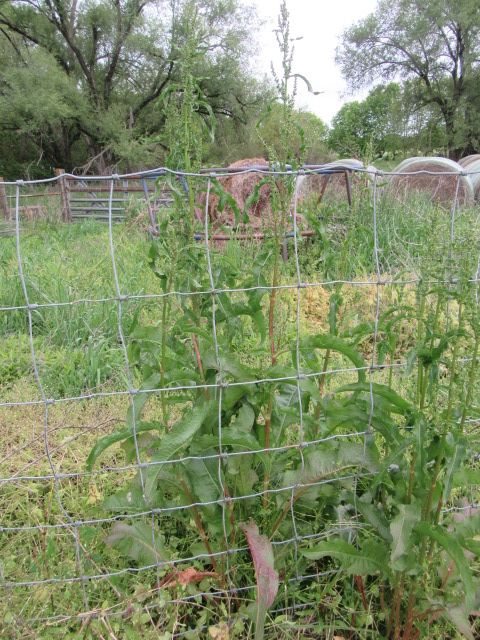
Rumex crispus (Curled Dock) on 5-11-20, #698-22.
Curled Dock, Curly Dock, Narrow Dock, Sour Dock, Yellow Dock
Rumex crispus
(Rumex crispus subsp. crispus)
ROO-meks KRISP-us
Synonyms of Rumex crispus: (2) (Updated on 12-23-23 from Plants of the World Online): Lapathum crispum (L.) Scop., Rumex patientia var. crispus (L.) Kuntze
Synonyms of Rumex crispus subsp. crispus (15) (Updated on 12-23-23): Lapathum crispum Garsault, Rheum crispum G.Don, Rumex coreanus Nakai, Rumex crispus var. fauriei (Rech.f.) Reveal, Rumex crispus subsp. fauriei (Rech.f.) Mosyakin & W.L.Wagner, Rumex crispus var. littoralis Vayr. (1902), Rumex crispus var. unicallosus Lej. & Courtois, Rumex elongatus Guss., Rumex fauriei Rech.f., Rumex kunthianus Schult. & Schult.f., Rumex kunthii Campd., Rumex lingulatus Schur, Rumex longifolius Kunth, Rumex luederi Münter, Rumex turcicus Boiss.
Rumex crispus L. is the accepted scientific name for Curled Dock. The genus and species were named and described as such by Carl von Linnaeus in the first volume of the first edition of Species Plantarum in 1753.
Accepted Infraspecific Names (5) (Updated on 12-23-23 from POWO): *Rumex crispus subsp. crispus (autonym), Rumex crispus subsp. littoreus (Hardy) Akeroyd, Rumex crispus subsp. robustus (Rech.) Pestova, Rumex crispus subsp. strictissimus (Rech.f.) Pestova, Rumex crispus subsp. uliginosus (Le Gall) Akeroyd. *When an infraspecific taxon is named, an autonym (“type-specimen”) is automatically generated whose description is closest to the (original) species. All have their own list of synonyms.
As of 12-23-23 when this page was last updated, Plants of the World Online lists 193 species in the Rumex genus. The genus is a member of the plant family Polygonaceae with a total of 55 genera. Those numbers could change periodically as updates are made by POWO.
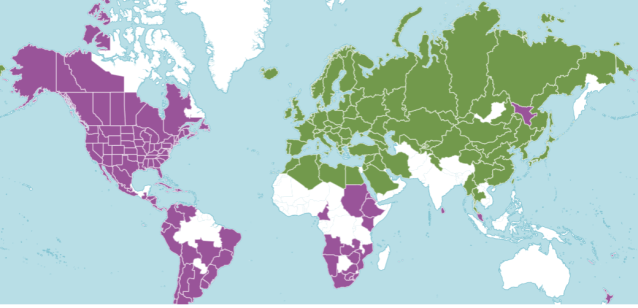
Distribution map of Rumex crispus from Plants of the World Online. Facilitated by the Royal Botanic Gardens, Kew. Published on the Internet; http://www.plantsoftheworldonline.org/. Retrieved on May 22, 2021.
The distribution map for Rumex crispus above is from Plants of the World Online and includes the species and all the subspecies. Areas in green are where the species is native and purple is where it has been introduced. You can click on the link and then go to the subspecies own pages. The map on the USDA Plants Database for North America is similar.
The map on iNaturalist shows where members have made observations. Anyone can join and it is a great website to confirm and share your observations. The maps on iNaturalist are continually updated as members post new observations.
THERE ARE SEVERAL LINKS AT THE BOTTOM OF THE PAGE FOR FURTHER READING AND TO HELP WITH A BETTER POSITIVE ID.
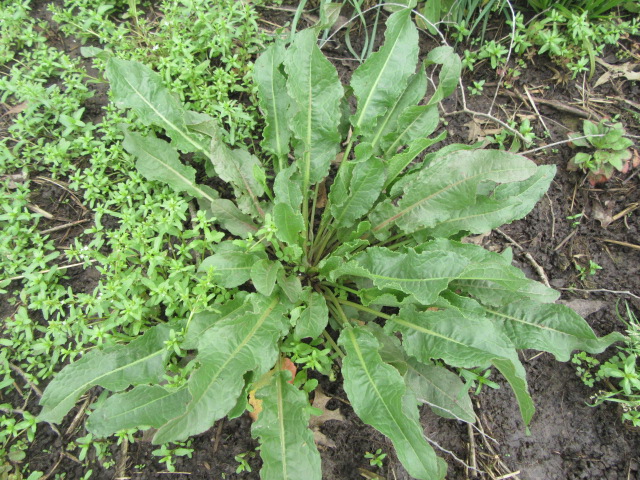
Rumex crispus (Curled Dock) on 4-7-20, #684-28.
Rumex crispus is an herbaceous perennial species that can be seen pretty much worldwide and many of us are familiar with it. There are many plants growing here on the farm mainly near the barn. Plants are among the first to come up in the spring, forming a good-sized rosette of leaves. The species has several common names including Curled Dock, Curly Dock, Narrow Dock, Sour Dock, Yellow Dock, and probably others. The above photo of a rosette was taken on April 7, 2020. All the photos on this page are from the same plant except the rosette above. Although there are several colonies on the farm, most of them were snacked on by the cows so I didn’t get any good photos until 2020. There are no cows here now and I have noticed a lot more wildflower species. I took photos of this Rumex crispus in the small lot next to the barn that is part of the corral.
There are a few more photos from 2022 at the bottom of the page.
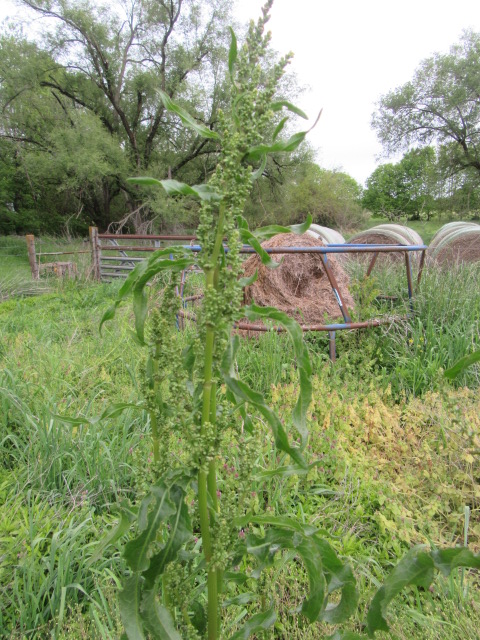
Rumex crispus (Curled Dock) on 5-11-20, #698-23.
Most information online says Rumex crispus grows to about 3 feet tall but the plant these photos are from grew to a little over 5 feet.
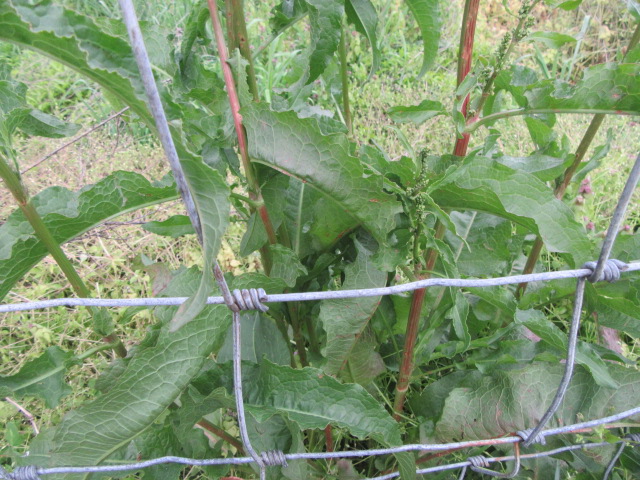
Rumex crispus (Curled Dock) on 5-11-20, #698-24.
Generally, Rumex crispus is usually unbranched except toward the top where the flowers appear. This particular plant had several stems coming from the base of the plant. Stems are hairless and ribbed.
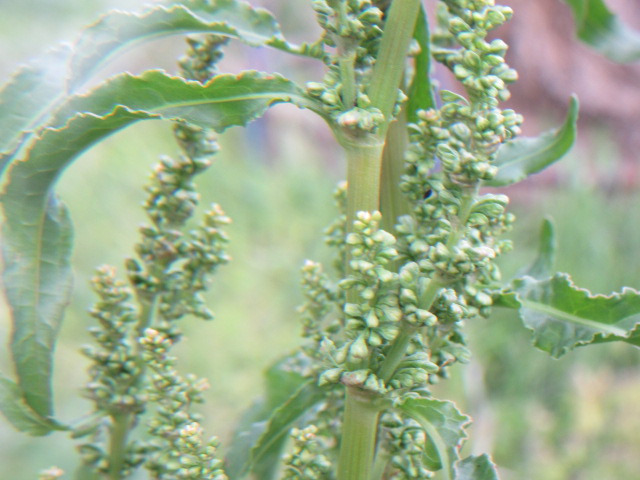
Rumex crispus (Curled Dock) on 5-11-20, #698-25.
The terminal inflorescence consists of bracteate panicles of racemes with whorls of flowers. Plants produce bisexual and female flowers (pistillate). Flowers have no scent and are pollinated by the wind.
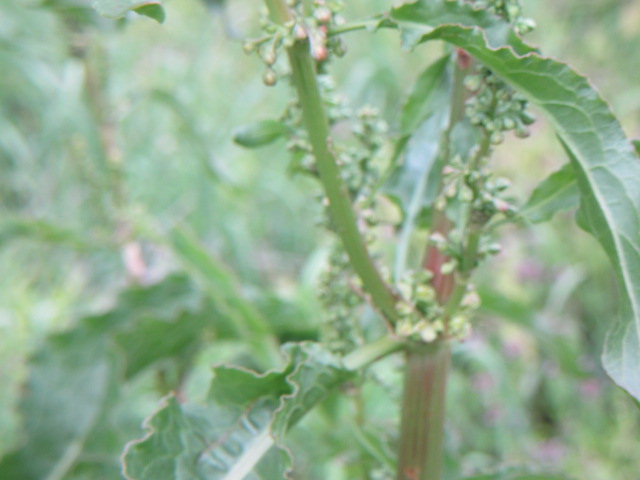
Rumex crispus (Curled Dock) on 5-11-20, #698-26.
The yellowish or reddish-green flowers have no petals and are about 1/8″ long and consist of 3 inner sepals, 3 outer sepals, 3 styles, and an ovary. The bisexual flowers also have 6 stamens.
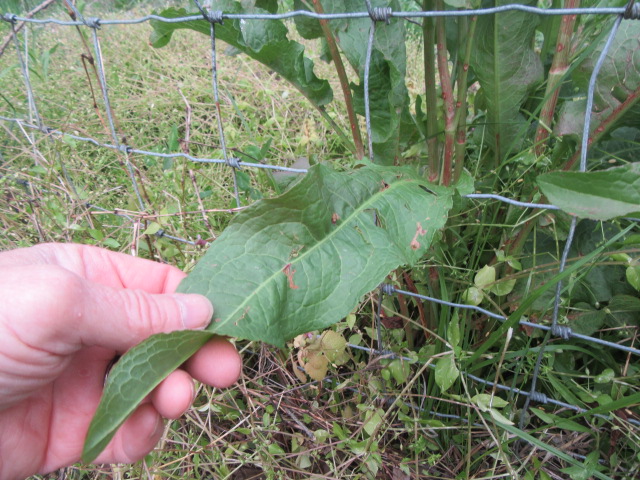
Rumex crispus (Curled Dock) on 5-11-20, #698-27.
Leaves grow in an alternate manner along the stem. Both the larger lower (basil) and smaller upper (cauline) leaves are lance-shaped and have a wavy or kind of curled appearance. Upper leaves are not as crisped or wavy as the basal leaves and have shorter petioles (leaf stems).
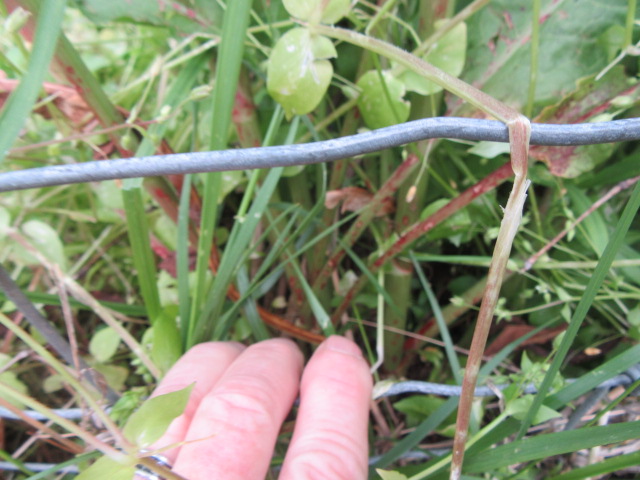
Rumex crispus (Curled Dock) on 5-11-20, #698-28.
The above photo shows multiple stems coming from the base of the plant.
Rumex crispus is a neat plant that doesn’t really get out of hand here. Some states have the species listed as an invasive, noxious weed.
This plant’s leaves are edible but have to be prepared in a certain way due to their high oxalic acid content. Young leaves can be used sparingly in salad and have a unique flavor. Plants have been used in herbal medicine.
I have enjoyed photographing and learning about the many wildflowers growing on the family farm and in other areas. The farm is in Windsor, Missouri in Pettis County (Henry County is across the street, and Benton and Johnson aren’t far away). I have grown over 500 different plants and identified over 250 species of wildflowers (most have pages listed on the right side of the blog). I am not an expert, botanist, or horticulturalist. I just like growing, photographing, and writing about my experience. I rely on several websites for ID and a horticulturalist I contact if I cannot figure them out. Wildflowers can be somewhat variable from location to location, so sometimes it gets a bit confusing. If you see I have made an error, please let me know so I can correct what I have written.
I hope you found this page useful and be sure to check the links below for more information. They were written by experts and provide much more information. Some sites may not be up-to-date but they are always a work in progress. If you can, I would appreciate it if you would click on the “Like” below and leave a comment. It helps us bloggers stay motivated. You can also send an email to me at thebelmontrooster@yahoo.com. I would enjoy hearing from you especially if you notice something is a bit whacky
FOR FURTHER READING:
PLANTS OF THE WORLD ONLINE (GENUS/SPECIES)
INTERNATIONAL PLANT NAMES INDEX (GENUS/SPECIES)
TROPICOS (GENUS/SPECIES)
FLORA OF NORTH AMERICA (GENUS/SPECIES)
WORLD FLORA ONLINE (GENUS/SPECIES)
WIKIPEDIA (GENUS/SPECIES)
USDA PLANTS DATABASE
MISSOURI PLANTS
MSU-MIDWEST WEEDS AND WILDFLOWERS
iNATURALIST
WILDFLOWER SEARCH
DAVE’S GARDEN
ILLINOIS WILDFLOWERS
MINNESOTA WILDFLOWERS
KANSAS WILDFLOWERS AND GRASSES
PFAF (PLANTS FOR A FUTURE)
GO BOTANY
EDIBLE WILD FOOD
FLORA FINDER
FRIENDS OF THE WILDFLOWER GARDEN
INVASIVE PLANT ATLAS
NOTE: The data (figures, maps, accepted names, etc.) may not match on these websites. It depends on when and how they make updates and when their sources make updates. Some websites have hundreds and even many thousands of species to keep up with. Accepted scientific names change periodically and it can be hard to keep with as well. Some of the links may use a name that is a synonym on other sites. In my opinion, Plants of the World Online by Kew is one 0f the most reliable and up-to-date plant databases and they make updates regularly. I make updates “at least” once a year and when I write new pages or add new photos but I do get behind. We are all a work in progress. 🙂
PHOTOS TAKEN IN 2022…
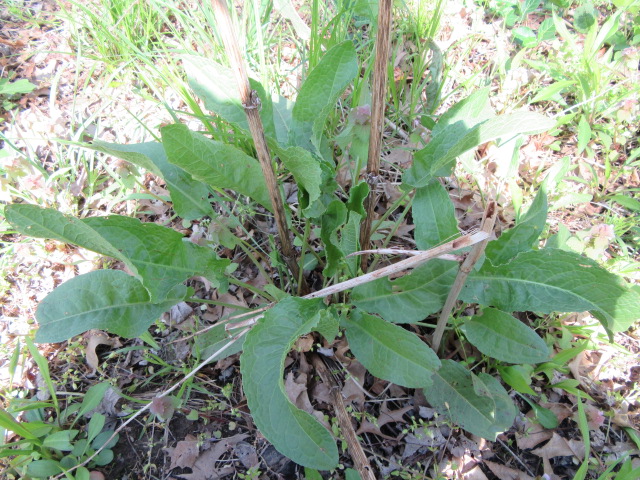
Rumex crispus (Curled Dock) on 4-27-22, #874-8.
Hmmm… There were more, but I decided they were of Rumex altissimus. Heck, the above photo could be as well. That’s what I get for uploading photos in the winter when I can’t go check. 🙂